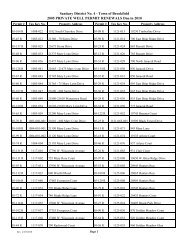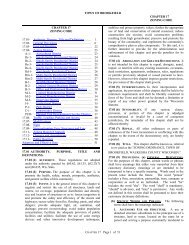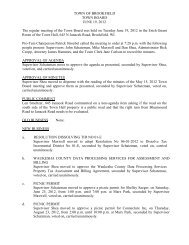Brown Water, Green Weeds - Water Resources Education ...
Brown Water, Green Weeds - Water Resources Education ...
Brown Water, Green Weeds - Water Resources Education ...
You also want an ePaper? Increase the reach of your titles
YUMPU automatically turns print PDFs into web optimized ePapers that Google loves.
<strong>Brown</strong> <strong>Water</strong>,<br />
<strong>Green</strong> <strong>Weeds</strong><br />
Familiar Signs of Runoff Pollution<br />
W<br />
Sediments<br />
henever rain falls or snow melts, water flows across farm fields and city streets and washes<br />
soil particles, pesticides, pet wastes, oil and other pollutants into lakes and streams. This process<br />
is called nonpoint source or runoff pollution. The symptoms of runoff pollution are all-too-familiar:<br />
weed-choked lakes, muddy rivers that flood frequently, and an over-abundance of carp in our<br />
favorite fishing holes. Sediments and nutrients cause many of the problems we see in streams<br />
and lakes.<br />
Sediments are soil particles eroded from construction sites, streambanks and cropland. Sediments also include dirt, flakes<br />
of metal, and small pieces of broken pavement washed off city streets. When these particles reach lakes and streams they<br />
do more than turn the water brown.<br />
. Sediments cause the water<br />
to become cloudy, or<br />
“turbid,” making it difficult<br />
for fish to see and feed<br />
properly. Sediments can<br />
also damage fish gills and<br />
impair the feeding and<br />
breathing processes in<br />
aquatic insects that<br />
fish eat.<br />
. Many fish and aquatic insects lay their eggs on gravel beds. When sediments are deposited on the stream bottom they<br />
cover this spawning habitat. They also destroy a stream’s natural “riffle and pool” pattern, producing a slow-moving, muddy,<br />
less attractive stream.
SEDIMENTS continued<br />
. Muddy or “murky” water<br />
contains millions of abrasive<br />
soil particles. In moving water<br />
these particles can “scour”<br />
aquatic plants and animals,<br />
removing them from their<br />
habitat.<br />
. Sediment deposits cause<br />
streams to become shallower<br />
and wider, increasing flooding<br />
problems. The shallow water<br />
is also heated more efficiently<br />
by the sun. This causes water<br />
temperatures to rise. Over<br />
time, cold water fish such as<br />
trout are replaced by warm<br />
water fish such as carp.<br />
. Sediments reduce visibility and increase the chances of<br />
propellers, rudders and keels running aground or hitting<br />
underwater hazards. Swimmers are also affected. Silted<br />
swimming areas are undesirable and can be dangerous<br />
if deep holes are filled with loose sediment.<br />
. Sediments cloud the water and cover plant leaves,<br />
reducing the amount of sunlight reaching desirable aquatic<br />
plants. Sediments also create soft, unstable beds for plant<br />
roots. The result is a decrease in food plants available to<br />
ducks. Sediment deposits also harm duck populations by<br />
filling in wetlands used for breeding.<br />
. Finally, sediments carry and store toxic materials that can<br />
contaminate small organisms. When fish and waterfowl eat<br />
the contaminated organisms, the toxins can accumulate in<br />
their bodies and cause illnesses, birth defects and death.
NUTRIENTS<br />
Nutrients such as phosphorus and nitrogen come from<br />
sediments, manure, pet wastes, improperly maintained septic<br />
systems and misapplications of fertilizers on lawns or farm fields.<br />
When these nutrients reach our lakes and streams they do more<br />
than just turn the water green.<br />
. Phosphorus contributes to the eutrophication or over-fertilization<br />
of lakes. This leads to an increase in undesirable weed and algae<br />
growth. Excess weeds and algae are harmful to fish and make a<br />
lake less attractive for swimming, boating, and other activities.<br />
. Excess algae can reduce populations of<br />
bottom-rooted plants by blocking sunlight.<br />
Bottom-rooted plants provide food and<br />
habitat for fish and waterfowl.<br />
. When algae and aquatic weeds die they are broken<br />
down by bacteria. Bacteria consume oxygen during<br />
the decomposition process and make it difficult for<br />
fish and other aquatic life to survive. Excess weeds<br />
and reduced oxygen levels also contribute to winter<br />
fish kills in shallow lakes.<br />
. When organic materials such as manure, pet wastes,<br />
leaves and grass clippings enter a lake or stream<br />
they are broken down by bacteria. The decomposition<br />
process reduces oxygen levels in the water and may<br />
release ammonia. Low oxygen levels and ammonia<br />
combined with warm temperatures can kill fish.
HELPING OUT<br />
. Runoff pollution upsets the delicate<br />
balance of aquatic communities, forces<br />
fish and wildlife that require clean water<br />
to find new homes, and ruins recreational<br />
opportunities. But we don’t have to settle<br />
for streams and lakes that are brown with<br />
sediment and green with algae…<br />
. Individuals and communities can<br />
take steps to improve water<br />
quality. If your favorite lake or<br />
stream is not as productive or<br />
beautiful as it once was, maybe it<br />
is suffering from runoff pollution.<br />
For more information about runoff<br />
pollution and what you can do to<br />
prevent it, contact your county<br />
University of Wisconsin–Extension<br />
office, Land Conservation<br />
Department, or the Department<br />
of Natural <strong>Resources</strong>.<br />
This publication is available from county UW-Extension offices or from Extension Publications,<br />
45 N. Charter St., Madison, WI 53715. (608) 262-3346 (toll-free 877-947-7827).<br />
Printed on<br />
recycled paper<br />
GWQ003<br />
<strong>Brown</strong> <strong>Water</strong>, <strong>Green</strong> <strong>Weeds</strong><br />
DNR WT-459-92<br />
R-01-01-6M-25-S<br />
A publication of the University of Wisconsin–Extension in cooperation with the Wisconsin Department<br />
of Natural <strong>Resources</strong>.<br />
©2001 by the Board of Regents of the University of Wisconsin System. Send inquiries about copyright<br />
permission to: Director, Cooperative Extension Publications, 201 Hiram Smith Hall, 1545 Observatory Dr.,<br />
Madison, WI 53706. University of Wisconsin-Extension is an EEO/Affirmative Action employer and provides<br />
equal opportunities in employment and programming, including Title IX and<br />
ADA requirements.<br />
Editing and design by the<br />
Environmental <strong>Resources</strong> Center,<br />
University of Wisconsin–Extension.








